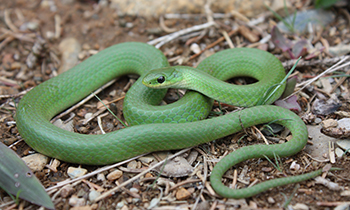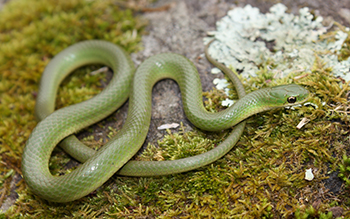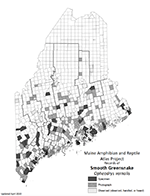Home → Fish & Wildlife → Wildlife → Species Information → Reptiles & Amphibians → Smooth Greensnake
Smooth Greensnake
Opheodrys vernalis
On this page:

Photo: Trevor Persons
Distinguishing Characteristics

Photo: Trevor Persons
- Small to medium-sized, approximately 14 to 20 inches in length
- Bright, grassy-green above
- Underside white or pale yellow
- Smooth scales
- Juveniles are dark olive or blue-gray and except for small size could be mistaken for North American racer
Status and Distribution in Maine
- Common and secure
- Southern, central, and eastern regions
Habitat
- Open areas, including meadows, grasslands, forest clearings, and suburban lawns and gardens
- Sometimes found on open ledge and hilltop clearings in mountains
Diet
- Primarily eats insects such as caterpillars, crickets, grasshoppers, ants, and flies
Seasonal Changes
- Hibernates in burrows from October through April, often with other snakes
Natural History Notes
- Green color a result of yellow pigment inside the scales, and blue color produced by the shape of the scale itself
- Quickly turns blue or blue-gray after death
- Lays eggs in late July or August under cover or rocks, or in loose substrate such as sand
Share Your Sighting
There is much still to learn about the distribution and ecology of Maine’s herpetofauna, and we encourage members of the public to share their photo-documented observations as part of the Maine Amphibian & Reptile Atlas Project (MARAP).
To see if a township still needs documentation of a species, consult this distribution map (PDF). If a township lacks a photo or specimen record, we want your observation!
There are two ways to share your observations:
Submit your reptile or amphibian observation online
No service? No problem. Click here to download the survey to your device while connected, then take offline to collect observations from anywhere. Tip: The survey works best on Google Chrome and Safari.
Or upload sightings to the iNaturalist citizen science project through their website at iNaturalist.org or mobile app.
- When submitting an observation through iNaturalist add a description of the location (and other noteworthy information) to the “notes” field. This serves as a check on the locations automatically generated by smartphone cameras, which may be imprecise if cell service or GPS coverage is weak.
Thank you for doing your part to help conserve Maine’s reptiles and amphibians.
